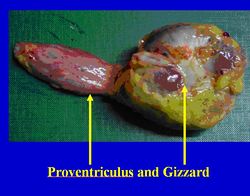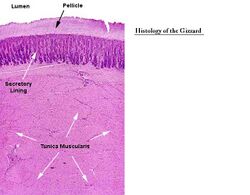Difference between revisions of "Gizzard - Anatomy & Physiology"
| Line 1: | Line 1: | ||
==Introduction== | ==Introduction== | ||
| − | The gizzard is also referred to as the muscular stomach or ventriculus. It is connected by the isthmus to the [[Proventriculus - Anatomy & Physiology|proventriculus]] and to the [[Duodenum - Anatomy & Physiology|duodenum]]. | + | The gizzard is also referred to as the muscular stomach or '''ventriculus'''. It is connected by the '''isthmus''' to the '''[[Proventriculus - Anatomy & Physiology|proventriculus]]''' and to the '''[[Duodenum - Anatomy & Physiology|duodenum]]'''. |
==Structure and Function== | ==Structure and Function== | ||
| − | [[Image:Gizzard Anatomy.jpg|thumb|right| | + | [[Image:Gizzard Anatomy.jpg|thumb|right|250px|Gizzard Anatomy - RVC 2008]] |
| − | + | The gizzard allows mechanical reduction of tougher material through powerful muscular development. It is cranial to the [[Avian Liver - Anatomy & Physiology|liver]] and [[Spleen - Anatomy & Physiology|spleen]] (contacts the [[Avian Liver - Anatomy & Physiology|liver]]). It contacts the sternum and lower left abdominal wall. Dorsally the abdominal air sacs separate it from the intestines and gonads. The [[Duodenum - Anatomy & Physiology|duodenum]] and [[Pancreas - Anatomy & Physiology|pancreas]] lies in its caudal right surface. It is more caudal than the [[Proventriculus - Anatomy & Physiology|proventriculus]] and is roughly on the midline of the bird. It is lens shaped and the interior is elongated by the cranial and caudal blind sacs. The cranial blind sac contacts the [[Proventriculus - Anatomy & Physiology|proventriculus]]. The pylorus is on right surface next to the cranial blind sac. | |
| − | + | The gizzard consisits of two thick masses of muscle that insert on tendonous surfaces. In seed eating birds, grit is digested to increase the grinding down of food particles. Its surface is covered by a glistening tendonous layer. The cranial and caudal extremities are formed by a powerful red muscular tissue. A circular '''aponeurosis''' is present, connecting the cranial end of the gizzard to the isthmus and the caudal end to the [[Duodenum - Anatomy & Physiology|duodenum]]. It appears yellow due to bile reflux from the [[Duodenum - Anatomy & Physiology|duodenum]]. When the thin muscles of the gizzard contract, food passes from the gizzard into the [[Duodenum - Anatomy & Physiology|duodenum]], when the thick muscles of the gizzard contract, food moves back into the [[Proventriculus - Anatomy & Physiology|proventriculus]]. | |
| − | + | [[Image:Gizzard Histology.jpg|thumb|right|250px|Gizzard Histology- Dr. Thomas Caceci]] | |
| − | |||
| − | |||
| − | |||
| − | |||
| − | |||
| − | |||
| − | |||
| − | |||
| − | |||
| − | |||
| − | |||
| − | |||
| − | |||
| − | |||
| − | |||
| − | |||
| − | |||
| − | |||
| − | |||
| − | |||
| − | |||
| − | |||
| − | |||
| − | |||
| − | |||
| − | |||
| − | |||
| − | |||
| − | |||
| − | |||
| − | |||
| − | |||
| − | |||
| − | [[Image:Gizzard Histology.jpg|thumb|right| | ||
| − | |||
| − | |||
==Species Differences== | ==Species Differences== | ||
| − | + | There is no gizzard in '''falconiformes''' (raptors etc.) or in '''stringiformes''' (owls etc.). There is also no gizzard in '''gulls'''. | |
| − | |||
| − | |||
| − | |||
| − | |||
==Other Information== | ==Other Information== | ||
| − | + | Grit should be provided in a seed eating birds diet. It is radiodense and marks out where the gizzard is located on radiographs. | |
| − | |||
| − | |||
| − | [[The Avian Alimentary Tract - Anatomy & Physiology - Flashcards|Avian Alimentary Tract Flashcards]] | + | '''Test yourself with the [[The Avian Alimentary Tract - Anatomy & Physiology - Flashcards|Avian Alimentary Tract Flashcards]]''' |
[[Category:Avian Alimentary System - Anatomy & Physiology]] | [[Category:Avian Alimentary System - Anatomy & Physiology]] | ||
| − | [[Category:To Do - | + | [[Category:To Do - AimeeHicks]] |
Revision as of 10:06, 14 September 2010
Introduction
The gizzard is also referred to as the muscular stomach or ventriculus. It is connected by the isthmus to the proventriculus and to the duodenum.
Structure and Function
The gizzard allows mechanical reduction of tougher material through powerful muscular development. It is cranial to the liver and spleen (contacts the liver). It contacts the sternum and lower left abdominal wall. Dorsally the abdominal air sacs separate it from the intestines and gonads. The duodenum and pancreas lies in its caudal right surface. It is more caudal than the proventriculus and is roughly on the midline of the bird. It is lens shaped and the interior is elongated by the cranial and caudal blind sacs. The cranial blind sac contacts the proventriculus. The pylorus is on right surface next to the cranial blind sac.
The gizzard consisits of two thick masses of muscle that insert on tendonous surfaces. In seed eating birds, grit is digested to increase the grinding down of food particles. Its surface is covered by a glistening tendonous layer. The cranial and caudal extremities are formed by a powerful red muscular tissue. A circular aponeurosis is present, connecting the cranial end of the gizzard to the isthmus and the caudal end to the duodenum. It appears yellow due to bile reflux from the duodenum. When the thin muscles of the gizzard contract, food passes from the gizzard into the duodenum, when the thick muscles of the gizzard contract, food moves back into the proventriculus.
Species Differences
There is no gizzard in falconiformes (raptors etc.) or in stringiformes (owls etc.). There is also no gizzard in gulls.
Other Information
Grit should be provided in a seed eating birds diet. It is radiodense and marks out where the gizzard is located on radiographs.
Test yourself with the Avian Alimentary Tract Flashcards

